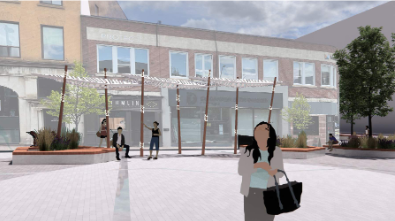THUNDER BAY – The price tag for a reconstruction of streets and underground infrastructure in the heart of Thunder Bay's north core has inflated significantly to $11 million.
City councillors representing the area, however, say the rising price tag will pay dividends by spurring economic development and transforming the downtown into a more dynamic public space.
The project would transform Red River Road between Court and Cumberland streets, as well as Court Street between Red River and Park Avenue, over the course of the 2023 and 2024 construction seasons.
The city will replace water and sewer lines and fully reconstruct the roadway and boulevards, with plans to introduce a curbless, “flexible” street on Red River designed to be partially or fully closed for markets and events.
City plans would expand pedestrian and public space, trimming Red River to two lanes and adding more seating, planters and greenery, and more room for patios.
The two-lane street would be designed with a "meandering alignment" as a traffic calming measure.
The plans also included changing Park Avenue and Van Norman into one-way streets in core areas, adding angled parking to compensate for spots that will be lost on Red River.
The changes were strongly supported by several hundred residents who took part in surveys and in person consultation events, and the city reports positive feedback from area businesses, despite the prospect of significant disruption over the next two years.
The project was spurred by the need to replace underground infrastructure that Kayla Dixon, the city’s director of engineering and operations, said date to the early 20th century.
Dixon updated city council on the cost increases and plans to stage construction over two seasons at a Monday meeting.
The city initially estimated the work at $6 to $8 million, but says the streetscape improvements and inflation in the construction industry accounts for a new cost estimate of $11 million.
Three city councillors who spoke with TBnewswatch said while that makes for a costly project, it remains worthwhile.
“Doing it right really matters, and I think citizens, generally speaking, are comfortable with the expense as long as they see a high-quality product that adds value to the community. I think this will do that," said Coun. Andrew Foulds, whose Current River ward includes the northern side of Red River Road.
Coun. Brian Hamilton, whose McKellar ward extends south from the other side of Red River, said he campaigned on a renewal of both of Thunder Bay's downtowns, noting the south core will also see significant investment through the demolition of Victoriaville and reopening of Victoria Avenue.
“All capital projects have gone up in price… so it’s no surprise that a project of this magnitude is also going to cost a lot more," he said. "Eleven million is not unexpected. My hope is that city council sees the opportunity here, and doesn’t scope down this project.”
Coun. Shelby Ch'ng compared the project to the city’s development of the waterfront at Prince Arthur’s Landing, saying that kind of public spending spurs private investment, too.
“I don’t think the Eaton’s building would have been purchased if the city and the province didn’t put money into that area, and right now we’re seeing the rewards for that. I think we can capitalize greater on it – $11 million today is certainly going to go a long way for setting us up for success.”
Of the project's total cost, just under $2 million involves replacing underground infrastructure, while over $9 million involves reconstructing the street and streetscape improvements.
The city will launch a call for tenders on the work in January, before the 2023 budget that will fund the project is ratified, in hopes of speeding progress on what Dixon called a significant project. She expects to return to council with a recommendation to award the contract by early March.
The proposed 2023 budget includes around $8 million for the project, while the city is hoping to find the remainder through applications to NOHFC and FedNor.
The city’s $1 million FedNor application has been approved to proceed to the second stage, while the city has not yet heard back on its $2 million application to NOHFC.
Staff and councillors alike promised the city would do everything it can to minimize the impact on businesses.
“There will be times when there will be no access, likely, into certain storefronts," said Dixon. "But generally, we will try to provide pedestrian access onto the street throughout construction.”
Foulds, who sits on the Waterfront Business Improvement Area (BIA) that represents many downtown businesses, said owners have been asking for improvements for years and see the benefits.
“At the end of the day, to be frank, it’s sort of temporary pain for what in my view is significant long-term gain," he said of construction disruptions.
Hamilton agreed, saying when improvements in the Bay and Algoma area closed the street in front of his business in 2011, it was disruptive but ultimately beneficial.
“Of course it was difficult for businesses… but we really liked the result," he said.
Consultants Brook McIlroy had advised the city consider connecting the downtown to the waterfront with a level crossing at Red River Road, and narrowing Water Street to two lanes in the area to calm traffic.
While there's "still interest" in the concept in the long run, it faces complications including negotiations with CN Rail and added infrastructure requirements, and is not being considered at this time, Dixon said.
